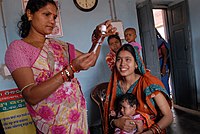
Photo from wikipedia
ABSTRACT Background: This paper explores the heterogeneities in antenatal care (ANC) utilization in India’s most populated state, Uttar Pradesh. Taking an intersectionality lens, multiple individual- and district-level factors are used… Click to show full abstract
ABSTRACT Background: This paper explores the heterogeneities in antenatal care (ANC) utilization in India’s most populated state, Uttar Pradesh. Taking an intersectionality lens, multiple individual- and district-level factors are used to identify segments of any antenatal care usage in Uttar Pradesh Objective: This paper seeks to understand the multilevel contexts of ANC utilization. The planning and programming challenge is that such knowledge of contextual specificity is rarely known upfront at the initial stages of planning or implementing an intervention. Exploratory data analysis might be needed to identify such contextual specificity. Methods: Tree-structured regression methods are used to identify segments and interactions between factors. The results from the tree-structured regression were complemented with multilevel models that controlled for the clustering of individuals within districts. Results: Heterogeneities in utilization of any ANC were observed. The multiple segments of ANC utilization that were developed went from a low utilization of 23.7% for respondents who were not literate and did not have home ownership to a high of 82.4% for respondents who were literate and at the highest level of wealth. Key variables that helped define the segments of ANC utilization include: woman’s literacy, ownership of home, wealth index, and district-level sex ratio. Based on the multilevel model of any ANC utilization, cross-level interactions also were obtained between sex ratio and ownership of home as well as between sex ratio and literacy. Increases in sex ratio increased the influence of ownership of home on any ANC, while increases in sex ratio reduced the impact of woman’s literacy on receiving any ANC. Conclusion: We argue that a focus on heterogeneous segments of utilization can help build knowledge of the mechanisms that underlie inequities in maternal health utilization. Such knowledge of heterogeneity needs to be incorporated in contextualizing interventions to meet a variety of recipients’ needs.
Journal Title: Global Health Action
Year Published: 2018
Link to full text (if available)
Share on Social Media: Sign Up to like & get
recommendations!